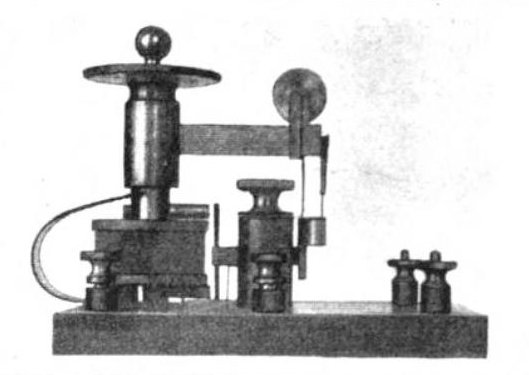Barretter detector on:
[Wikipedia]
[Google]
[Amazon]
 The hot-wire barretter was a demodulating detector, invented in 1902 by
The hot-wire barretter was a demodulating detector, invented in 1902 by
Detectors of electrical oscillations
*Secor, H. Winfield (January, 1917)
'' The Electrical Experimenter'', pages 652+, accessed 2007-12-20. {{Electronic component History of radio Radio electronics Detectors Canadian inventions
 The hot-wire barretter was a demodulating detector, invented in 1902 by
The hot-wire barretter was a demodulating detector, invented in 1902 by Reginald Fessenden
Reginald Aubrey Fessenden (October 6, 1866 – July 22, 1932) was a Canadian-American electrical engineer and inventor who received hundreds of List of Reginald Fessenden patents, patents in fields related to radio and sonar between 1891 and 1936 ...
, that found limited use in early radio receiver
In radio communications, a radio receiver, also known as a receiver, a wireless, or simply a radio, is an electronic device that receives radio waves and converts the information carried by them to a usable form. It is used with an antenna. ...
s. In effect, it was a highly sensitive thermoresistor, which could demodulate amplitude-modulated signals, something that the coherer
The coherer was a primitive form of radio signal detector used in the first radio receivers during the wireless telegraphy era at the beginning of the 20th century. Its use in radio was based on the 1890 findings of French physicist Édouard Bra ...
(the standard detector of the time) could not do. Tapan K. Sarkar, Robert Mailloux, Arthur A. Oliner, Magdalena Salazar Palma, Dipak L. Sengupta, "History of Wireless",
, January 2006, Wiley-IEEE Press, page 369.
The first device used to demodulate amplitude modulated signals, it was later superseded by the electrolytic detector, also generally attributed to Fessenden. The barretter principle is still used as a detector for microwave
Microwave is a form of electromagnetic radiation with wavelengths shorter than other radio waves but longer than infrared waves. Its wavelength ranges from about one meter to one millimeter, corresponding to frequency, frequencies between 300&n ...
radiation, similar to a bolometer
A bolometer is a device for measuring radiant heat by means of a material having a temperature-dependent electrical resistance. It was invented in 1878 by the American astronomer Samuel Pierpont Langley.
Principle of operation
A bolometer ...
.
Description and construction
Fessenden's 1902 patent describes the construction of the device. A fineplatinum
Platinum is a chemical element; it has Symbol (chemistry), symbol Pt and atomic number 78. It is a density, dense, malleable, ductility, ductile, highly unreactive, precious metal, precious, silverish-white transition metal. Its name origina ...
wire, about in diameter, is embedded in the middle of a silver
Silver is a chemical element; it has Symbol (chemistry), symbol Ag () and atomic number 47. A soft, whitish-gray, lustrous transition metal, it exhibits the highest electrical conductivity, thermal conductivity, and reflectivity of any metal. ...
tube having a diameter of about . This compound wire is then drawn until the silver wire has a diameter of about ; as the platinum wire within it is reduced in the same ratio, it is drawn down to a final diameter of . The result is called Wollaston wire.
The silver cladding is etched off a short piece of the composite wire, leaving an extremely fine platinum wire; this is supported, on two heavier silver wires, in a loop inside a glass bulb. The leads are taken out through the glass envelope, and the whole device is put under vacuum and then sealed.
Operation
The hot-wire barretter depends upon the increase of a metal resistivity with increasing temperature. The device is biased by adirect current
Direct current (DC) is one-directional electric current, flow of electric charge. An electrochemical cell is a prime example of DC power. Direct current may flow through a conductor (material), conductor such as a wire, but can also flow throug ...
adjusted to heat the wire to its most sensitive temperature. When there is an oscillating current from the antenna through the extremely fine platinum wire loop, the wire is further heated as the current increases and cools as the current decreases again. As the wire heats and cools, it varies its resistance in response to the signals passing through it. Because of the low thermal mass
In building design, thermal mass is a property of the matter of a building that requires a flow of heat in order for it to change temperature.
Not all writers agree on what physical property of matter "thermal mass" describes. Most writers use ...
of the wire, it is capable of responding quickly enough to vary its resistance in response to audio signals. However, it cannot vary its resistance fast enough to respond to the much higher radio frequencies. The signal is demodulated because the current supplied by the biasing source varies with the changing wire resistance. Headphones are connected in series with the DC circuit, and the variations in the current are rendered as sound.
See also
* Electrolytic detector a development of the barretter detector. * Iron-hydrogen resistorReferences
External links
Patents
* , "Current Actuated Wave Responsive Device" – August, 1902 ("barretter" detector) * , "Receiver for Electromagnetic Waves" – May, 1903 (improved "barretter")Other
Detectors of electrical oscillations
*Secor, H. Winfield (January, 1917)
'' The Electrical Experimenter'', pages 652+, accessed 2007-12-20. {{Electronic component History of radio Radio electronics Detectors Canadian inventions